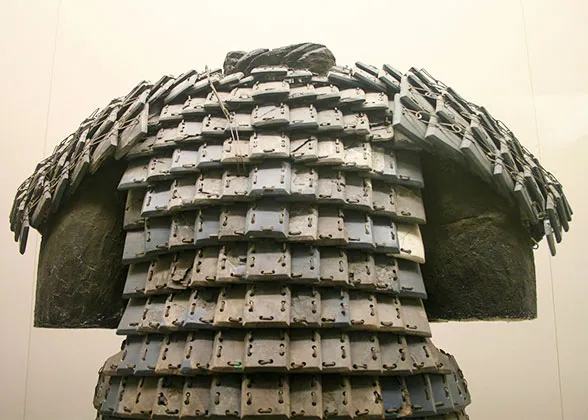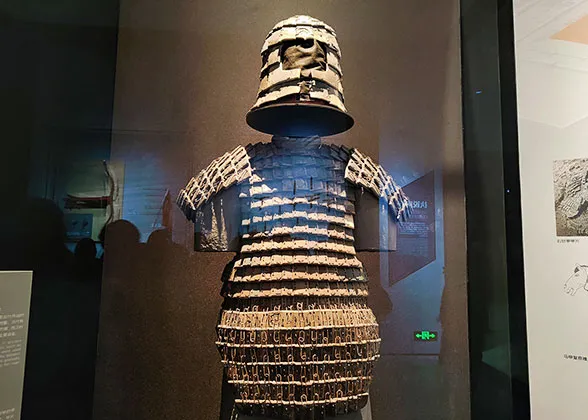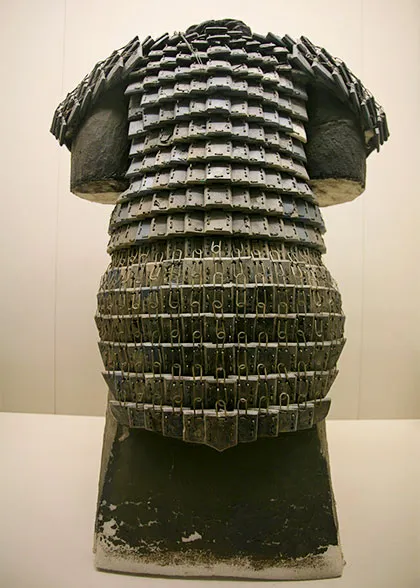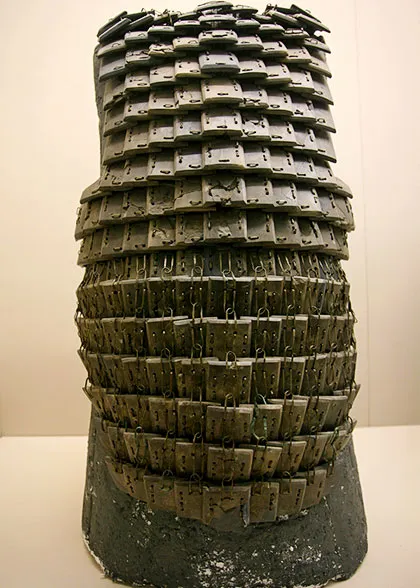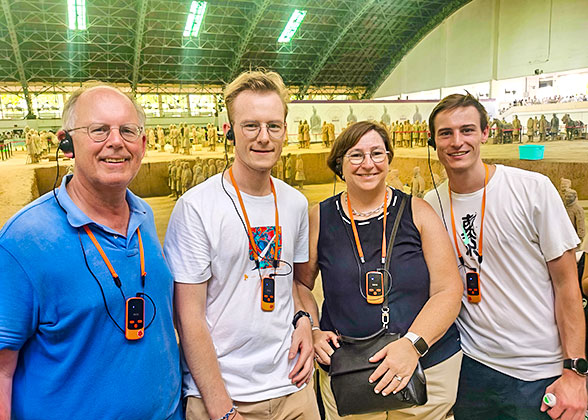Pit K9801 – Stone Armor and Helmets
The accessory pit K9801 of Qin Shi Huang Mausoleum, first discovered by a farmer from nearby Xiachen Village in 1996, is located in the southeastern part of the Qin Shi Huang Mausoleum between the inner and outer city walls, approximately 200 meters (220 yards) from the mausoleum mound. With a rectangular layout measuring 130 meters (430 feet) from east to west and 100 meters (330 feet) from north to south, it covers over 13,000 square meters (3.2 acres), making it the largest one among the accessory pits discovered inside the Qin Shi Huang Mausoleum to date. The unearthed relics in this pit are mainly stone armor and stone helmets, leading archaeologists to speculate that it may have served as an arsenal or military facility, which also dispels the rumor that the Qin army did not use helmets.
Currently, the pit is closed to the public, but its relics are displayed at the Exhibition Hall of Historical Relics in the Terracotta Warriors and Horses Museum, accessible with the Terracotta Army through ticket.
At present, archaeologists have excavated an area of about 153 square meters (183 square yards) in Pit K9801, uncovering many recognizable stone relics, including 87 pieces of armor, 43 helmets, and 3 bridle reins. It is estimated that there are up to five million stone pieces buried underground, forming stone armor, helmets, and other military equipment. In addition to these, other cultural relics such as components of stone bridle reins and bronze chariots and horses, copper attachments for wooden wares, and copper short axes were also discovered.
Scholars believe that the stone armor and helmets here are not practical for actual combat, citing three key reasons. First, the complicated crafting process makes large-scale production unfeasible. Second, research indicates that the weight of each set of stone armor and helmet is about 25 kilograms (55 pounds), which is impossible to wear for long, let alone to fight in a war. Lastly, using stone with poor toughness for crafting armor and helmets clearly indicates their purpose as burial objects rather than practical combat gear.
 More Accessory Pits:
More Accessory Pits:
 Pit K0006 - Civil Official Figures
Pit K0006 - Civil Official Figures
 Pit K9901 - Acrobatics Figures
Pit K9901 - Acrobatics Figures
 Pit K0007 - Bronze Aquatic Birds
Pit K0007 - Bronze Aquatic Birds
 Further Reading:
Further Reading:
 Exhibition of Archaeological Discoveries
Exhibition of Archaeological Discoveries
 Why are there partition walls in the pit of Terracotta Army?
Why are there partition walls in the pit of Terracotta Army?
Currently, the pit is closed to the public, but its relics are displayed at the Exhibition Hall of Historical Relics in the Terracotta Warriors and Horses Museum, accessible with the Terracotta Army through ticket.
Excavated Cultural Relics
1. Stone Armors
The stone armors measure approximately 75 cm (29.5 in.) in length, with a single one composed of about 600 stone pieces. Finer armors may be manufactured by up to 800 stone pieces, weighing around 18 kilograms (40 pounds) in total. The stone pieces used to craft the armors feature shapes such as rectangles, squares, trapezoids, and fish scales. Each stone piece is uniformly thin, approximately 0.6 - 0.8 cm (0.2 - 0.3 in.), and linked by bronze wires, forming an integrated set including chest armor, back armor, hip armor, and skirt armor to provide full-body protection.
|
|
2. Stone Helmets
The stone helmets stand 31.5 cm (12.4 in.) tall and consist of 72 stone pieces, extending about 30 cm (11.8 in.) from the top to the lower edges, protecting the shoulders and neck. Using the same bronze-wire connecting technique used for the stone armors, the stone helmets are crafted from pieces of various shapes: circular, trapezoidal, curved, and others. These stone pieces are categorized into top pieces and side pieces, with the lowest layer flaring outward to fit closely against the head. When worn, only the eyes and nose remain exposed.
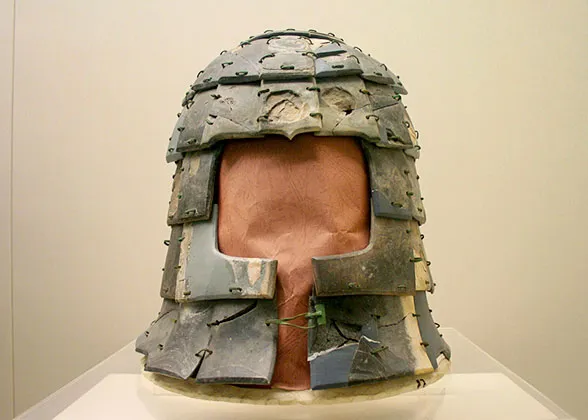 |
| Crafted Stone Helmet |
3. Horses' Stone Armors
The stone horse armor, measuring about 1.8 meters (5.9 feet) in length, is notably larger. It comprises neck armor, chest armor, body armor, and rear-covering armor. The stone pieces of neck armor curve outward slightly, extending from the base of the head to connect with the body armor, offering comprehensive protection. These armors are suitable for both chariot horses and cavalry horses.
How to Make Stone Armor and Helmets?
The exquisite stone armor and helmets were crafted using advanced techniques. The primary material is bluish-gray stone from Weinan City, located about 75 kilometers (47 miles) from the mausoleum site. The processing steps were:
1. Material Selection: Choose uniform, moderately hard, layered bluish-gray stone with a smooth texture and bright luster, ensuring ease of cutting, polishing, and drilling.
2. Initial Processing: Process rough stones to make them slightly larger than the final dimensions required to allow for further refinement.
3. Shaping and Marking: Polish the processed rough stones into the desired curvature and shape. Carve symbols or characters as guides for positions, quantities, and shapes of stone pieces.
4. Drilling: Drill holes according to the specific requirements of each stone piece.
5. Secondary Polishing: Refine the shaped stone pieces by removing marks caused by drilling and correcting any imperfections.
6. Connecting with Wires: Connect the individual stone pieces using silk ribbons or bronze wires.
7. Final Integration: Join the assembled sections at the seams with bronze wires to complete the armors and helmets.
Through experiments by archaeologists, it requires one person to work 8 hours a day for about 344 to 444 days to finish a stone armor with about 600 stone pieces. Considering the staggering five million stone pieces buried in pit K9801, you can imagine what a large group of people have been involved in the construction of the mausoleum.
|
|
Through experiments by archaeologists, it requires one person to work 8 hours a day for about 344 to 444 days to finish a stone armor with about 600 stone pieces. Considering the staggering five million stone pieces buried in pit K9801, you can imagine what a large group of people have been involved in the construction of the mausoleum.
The Stone Armor and Helmets Are Not for Real Battle
Recommended Tours
- Last updated on Aug. 25, 2025 by Doris Xue -
